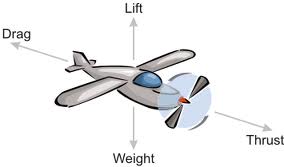How does one get up in the air? What mysterious forces are at work that allow one to partake in the miracle of flight? As comedian Louis C.K. stated, “[You can go] New York to California in 5 hours. That used to take 30 years.”
There is no denying that the act of flight has changed the way people live and get around. But how does it actually work? How does something that you can’t see support that which is now often so big the eye can’t even take it in? What forces are at work that allow you to literally sit in the sky?
There are four basic forces that act on an aircraft in flight:
1. Thrust, as defined by every new pilot’s favourite book, From The Ground Up, is “the force exerted by the engine and its propeller(s) which pushes the air backward with the object of causing a reaction, or thrust, in the forward direction”;
2. Drag opposes thrust, or is the resistance to forward motion;
3. Lift is the upward force that sustains an airplane in flight; and
4. Gravity directly opposes lift. Remember Newton, apple? You get the idea.
In a nutshell, thrust is the forward force, drag the backward force, lift the upward force, and gravity the downward force. When these 4 forces are in equilibrium (thrust = drag, and lift = gravity) the aircraft will continue to move forward at the same speed and altitude.
Photo from aerodynamics101.blogspot.com
If thrust is greater than drag, the aircraft will speed up. And if drag is greater than thrust, the aircraft will slow down.
The same relationship exists between lift and gravity. If lift is greater than gravity, the aircraft will climb or gain altitude. If gravity is greater than lift, the aircraft will descend.
As most people know, it is the wings of an aircraft that create the most lift. Through much research and development it has been discovered that a curved or cambered shape works best.
Photo from mansfieldct.org
To really explain lift, let’s go back to Sir Isaac Newton and look at his Laws of Motion.
Newton’s First Law: an object in motion tends to stay in motion.
- When you introduce an airfoil (like a wing) into a stream of air, the uniform flow of the air is disturbed, or split. Some air flows over the top of the wing, and some flows below.
Newton’s Second Law: to alter the state of a uniform body in motion, an outside force must be applied.
- The airfoil acts on the uniform body (the air) to create a change in airflow direction.
Newton’s Third Law: for every action there is an equal and opposite reaction.
- The reaction is lift.
Now we’re getting to the really cool part – my good friend Daniel Bernouilli. He was one smart dude and discovered that the total energy in any system remains constant. Flowing air is treated like a moving fluid in that it contains energy in the form of speed and pressure. This means that if the air flowing over the top of the wing increases in speed (due to the curvature or camber), then some other form of energy must decrease – in this case, pressure. So now we have an area of decreased pressure on the top of the wing, and an area of increased pressure below – voila! Lift!
Photo from efm.leeds.ac.uk
Stay tuned for Flying 102, coming soon to a Blog Spot near you!




No comments:
Post a Comment